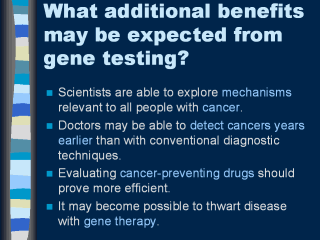|
|
|
|
front |1 |2 |3 |4 |5 |6 |7 |8 |9 |10 |11 |12 |13 |14 |15 |16 |17 |18 |19 |20 |21 |22 |23 |24 |25 |26 |27 |28 |29 |30 |31 |32 |33 |34 |35 |36 |37 |38 |39 |40 |Glossary |review |
 |
Tracking down the gene that causes an inherited cancer has implications for all
cancers, inherited or not. A healthy allele of the same gene, if it undergoes
mutations triggered by the environment during a person's lifetime, may lead to
noninherited cancers. Thus, by identifying a cancer gene, scientists are able to
explore mechanisms relevant to all people with cancer. Genes and gene markers may also provide tools for improving cancer diagnosis and treatment. By spotting a mutated gene (or its protein product) in cells shed into stool, urine, or saliva, or in tissue biopsies, doctors may be able to detect cancers years earlier than with conventional diagnostic techniques. (It has even been suggested that some day probes for a mutated gene could be injected, then traced on an x-ray.) Evaluating cancer-preventing drugs, too, should prove more efficient once the drugs can be tested in populations that are highly likely to develop the cancer. Or, if a gene is found to produce some antitumor protein, it might be possible to synthesize that protein and use it as a drug. Ultimately, it may become possible to thwart disease with gene therapy - inactivating the flawed gene or replacing it. |